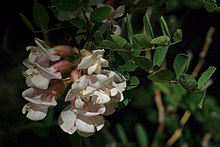| Robinia neomexicana | |
|---|---|

| |
| Conservation status | |
 Least Concern (IUCN 3.1) | |
 Apparently Secure (NatureServe) | |
| Scientific classification | |
| Kingdom: | Plantae |
| Clade: | Tracheophytes |
| Clade: | Angiosperms |
| Clade: | Eudicots |
| Clade: | Rosids |
| Order: | Fabales |
| Family: | Fabaceae |
| Subfamily: | Faboideae |
| Genus: | Robinia |
| Species: | R. neomexicana |
| Binomial name | |
| Robinia neomexicana A.Gray | |

| |
| Natural range | |
| Synonyms | |
List
| |
Robinia neomexicana, the New Mexican, New Mexico, Southwest, desert, pink, or rose locust, is a shrub or small tree in the subfamily Faboideae of the family Fabaceae.
Distribution
Robinia neomexicana is native to the Southwestern United States (southeastern California and southwestern Utah, Virgin River region, east through Arizona and New Mexico, the Rio Grande valley, to far west Texas) and adjoining northern Mexico; from central New Mexico the range extends north into Colorado, mostly the eastern foothills of the Rocky Mountains. In Arizona, it ranges across the Arizona transition zone, the Mogollon Rim and White Mountains, and into western and southwestern New Mexico.
In California, it is uncommon below 1500 m (5000 ft) in canyons in the Mojave Desert and its sky island pinyon-juniper habitats (Pinus monophylla and Juniperus californica). Farther east, it is typically found between 1200 and 2600 meters (4000 and 8500 feet) along streams, in the bottoms of valleys, and on the sides of canyons.
Description
Robinia neomexicana grows to 5–10 m tall (rarely to 15 m) with bristly shoots. The leaves are 10–15 cm long, pinnate with 7–15 leaflets; they have a pair of sharp, reddish-brown thorns at the base. The flowers are showy and white or pink, and considered fragrant. Blooms are produced in spring or early summer in dense racemes 5–10 cm long that hang from the branches near the ends. The fruits are brown bean-like pods with bristles like those on the shoots.
Uses
In New Mexico, Pueblo Native Americans traditionally ate the flowers uncooked. The pods were also eaten raw and cooked by some Native Americans, such as the Mescalero and Chiricahua Apache.
Mule deer, cattle, and goats browse the plant foliage. Cattle also eat the plant's flowers. Squirrels and quail eat the locust's seeds.
References
- Contu, S. (2012). "Robinia neomexicana". IUCN Red List of Threatened Species. 2012: e.T19892906A20138525. doi:10.2305/IUCN.UK.2012.RLTS.T19892906A20138525.en. Retrieved 12 November 2021.
- NatureServe (2024). "Robinia neomexicana". Arlington, Virginia. Retrieved 21 August 2024.
- "Robinia neomexicana A.Gray". Plants of the World Online. Royal Botanic Gardens, Kew. Retrieved 21 August 2024.
- ^ Little Jr., Elbert L. (1976). "Map 162, Robinia neomexicana". Atlas of United States Trees. Vol. 3 (Minor Western Hardwoods). US Government Printing Office. LCCN 79-653298. OCLC 4053799.
- ^ "Jepson Manual Treatment". University of California. 1993. Retrieved 2008-06-18.
- ^ Elmore, Francis H. (1976). Trees and Shrubs of the Southwest Uplands. Western National Parks Association. p. 134. ISBN 0-911408-41-X.
- "Fragrant Flowers and Plants – Southeastern Arizona Wildflowers and Plants".
- Dunmire, William W.; Tierney, Gail D. (1995). Wild plants of the Pueblo Province : exploring ancient and enduring uses. Museum of New Mexico Press. ISBN 0890132828. OCLC 32501881.
- Peattie, Donald Culross (1953). A Natural History of Western Trees. New York: Bonanza Books. p. 592.
- Little, Elbert L. (1994) . The Audubon Society Field Guide to North American Trees: Western Region (Chanticleer Press ed.). Knopf. p. 504. ISBN 0394507614.
External links
 Media related to Robinia neomexicana at Wikimedia Commons
Media related to Robinia neomexicana at Wikimedia Commons- USDA Plants Profile: Robinia neomexicana
- Jepson Manuel Treatment - Robinia neomexicana
| Taxon identifiers | |
|---|---|
| Robinia neomexicana |
|